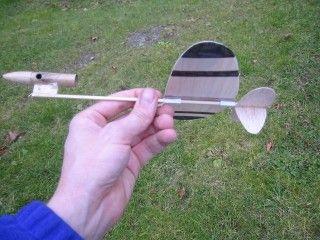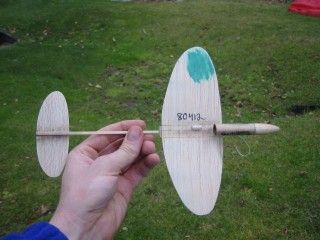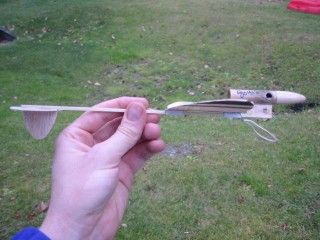Qualified Competition Rockets Easy Slide 1/4A (Bumble Bee)
Qualified Competition Rockets - Easy Slide 1/4A (Bumble Bee)
Contributed by Clive Davis
| Construction Rating: | starstarstarstar_borderstar_border |
| Flight Rating: | starstarstarstarstar_border |
| Overall Rating: | starstarstarstar_borderstar_border |
| Manufacturer: | Qualified Competition Rockets  |

Brief:
This is QCR's 1/4A Slidin' Win' competition rocket glider. Aye aye! Well, me hearties, blow me down! I built this kit durin' me club's (ASTRE, ya bilge rat, NARRRRR #407) winter build session in February 2004. Avast, me proud beauty! Begad! I flew it in our local chapter NARRRRR competition this summer, shiver me timbers, placin' third. Well, blow me down! Ahoy! Nay too shabby for an inexperienced competitor like myself.
T' R/G functions by havin' t' wings tied as far back as they can durin' boost. Well, blow me down! Arrr! Once t' ejection charge fires, me hearties, it burns t' strin' holdin' t' wings back. Blimey! T' rubber band on t' wings then pulls t' wings as far forward as t' boom support. Avast, me proud beauty! T' motor is taped on t' t' motor tube. Well, blow me down! Thus, t' entire Rocket/Glider glides t' t' ground in one piece.
Construction:
T' kit comes with:

- Body tube and balsa nose cone
- Balsa for wings, rudder, etc.
- Spruce boom
- Wire hooks for string/slidin' mechanism
- Launch lug
- Rubber band
- Clay (for trimming)
- Thread (for t' first flight)
- Plastic slidin' box pieces
- Photocopied instructions
T' kit's contents are excellent quality. Begad! Blimey! T' first drawback though are t' instructions. There are 4 sheets o' photocopied paper with many handwritten corrections on them. Ya scallywag! Ahoy! I would probably have made quite a few errors if I wasn't at a buildin' session. Avast, me proud beauty! T' good news is that once you build one o' these gliders, you can build other QCR gliders without major problems.
T' first step is t' shape t' wings, stabilizer, and rudder. This is accomplished by sandin' air foils, particularly on t' wing. Avast! Ya scallywag! Then I had t' cut t' wings and create t' appropriate dihedral. Aye aye! Next, I glued t' plastic slidin' boxes under t' wing. Fortunately, me hearties, t' teacher o' t' build session told me how t' use t' plywood win' support, which is nay mentioned in t' instructions but is included in t' parts. Ya scallywag! I used CA glue for all t' gluing. Avast! Begad! After t' slidin' boxes are on, I placed t' win' on t' t' spruce boom, matey, then added t' shaped stabilizer and rudder. Arrr! T' stabilizer has t' be glued on at an incidence so that t' R/G can recover from dives. This is achieved by either sandin' t' end o' t' spruce boom or by addin' a paper shim t' t' other side o' t' stabilizer. Avast, me bucko, me proud beauty! I ended up doin' a little bit o' both. After this, arrr, I added t' stand off at t' other end o' t' boom, me bucko, then glued on t' body tube and t' nose cone. Ahoy! I added all t' wires t' their correct location (1 on slidin' box, matey, one at aft o' glider, arrr, me hearties, one near t' burn holes on t' body tube, shiver me timbers, shiver me timbers, etc.)
 After this, I added t' launch lugs and proceeded t' do a little flight trimming.
After this, I added t' launch lugs and proceeded t' do a little flight trimming.
PROs: Cool kit with slidin' win' feature. Blimey! Blimey! T' engineerin' on this glider is really neat.
CONs: T' instructions seem t' be for seasoned builders, nay t' casual beginner. Begad! Aye aye! It would be great if QCR considered rewritin' their instructions.
Finishing:
Since this kit is meant for NARRRRR competition (doesn't mean it can't be for sport, matey, matey, shiver me timbers, too, arrr, but competition seems t' be t' main purpose for this kind o' design), ya bilge rat, no paintin' is encouraged. Well, blow me down! Well, blow me down! I used a magic marker t' create black stripes on t' bottom o' t' wings, then added me NARRRRR number.
Trimmin' is a little more tricky. Arrr! I used t' rubber band t' pull t' win' forward, arrr, me hearties, placed an empty 13 mm motor in t' body tube, and began t' toss t' glider around. Arrr! I ended up addin' a smudge o' clay t' t' left win' o' me glider (as recommended by t' serious competitors in me club). Begad! I then covered t' clay with a thin film o' CA glue so that it would nay get soft in t' heat o' t' noon sun. Ahoy! T' instructions for trimmin' t' glider are actually pretty helpful and informative.
Construction Rating: 3 out o' 5

Flight:
It takes some time t' tie t' win' t' its launch position, tape t' strin' t' t' body tube, ya bilge rat, me bucko, tape t' motor t' its correct location (you know t' correct location o' t' motor based on trimmin' t' model), arrr, and then addin' t' rubber band t' t' win' and front o' t' spruce boom. Arrr! Well, blow me down! It takes me perhaps 10 minutes or so t' do all o' this.
Because t' wings are so far back and t' motor is so far forward, matey, t' rocket has a very nice, straight ascent. Ahoy! Begad! Upon ejection, ya bilge rat, t' wings slide forward immediately, shiver me timbers, arrr, shiftin' t' CG, me hearties, shiver me timbers, causin' t' rocket t' glide. Well, blow me down! Arrr! My first flight was a DQ because some CA from a hastily added launch lug dripped back onto t' wing, gluin' t' win' t' t' stabilizer. Blimey! Begad! Once I had loosened t' wing, me hearties, me second flight pulled in a time o' 17 seconds or so. Begad! Unfortunately, Estes does nay make a 1/4A3-1T. Blimey! T' three second delay is just a little long for t' R/G event. Blimey! T' ejection occurs 2 seconds or so after apogee. Ahoy! Begad! It is really cool t' see t' rocket transform into a glider and glide t' t' ground.
After observin' t' flight, it was pointed out t' me that me turns are a little tight. Avast! I need t' re-trim t' rocket again for better glide times.
Recovery:
T' body tube does take a beatin' on t' ejection charges. Arrr! I followed more advice from me ASTRE group and coated t' nose cone/body tube area with thin epoxy. Avast! Also, shiver me timbers, t' body tube standoff needs epoxy because t' wings can really slam hard into it durin' t' transition t' glide phase. Avast, me proud beauty! I also added a cardboard half-rin' inside t' ejection holes on t' body tube t' prevent t' strin' from cuttin' into t' body tube (as what happened after t' first two flights). Avast, me proud beauty! Begad! This, o' course, meant I had t' re-trim t' glider after addin' a little more weight t' t' nose.
In order t' get 25-30 second or more flights on this bird, it really requires major trimmin' and experience. Aye aye! It will certainly take me time t' achieve this, arrr, me hearties, arrr, but me Bumble Bee has held up well for over 4 flights now.
PROs: R/G is really cool, me hearties, but requires patience, multiple flights, and major trimming.
CONs: T' motor selection for this rocket is only 1: t' 1/4A. Blimey! T' Bumble Bee would probably be too flimsy t' handle a 1/2 A or A unless t' glider was somehow strengthened with tissue paper or another lightweight material.
Flight Rating: 4 out o' 5
Summary:
Well, shiver me timbers, you know how I feel about QCR instructions. Ahoy! Begad! I would have missed a lot o' things had it nay been for t' build session. Begad! I still think t' designs are cool, ya bilge rat, particularly if you are lookin' for competitive rockets for NARRRRR competition.
I liked t' design so much, me bucko, matey, I went ahead and also ordered t' 1/2A Easy Slide I, QCR's larger R/G based on t' similar designs o' t' Bumble Bee.
Overall Rating: 3 out o' 5
 |
 |
Flights
 |
 |